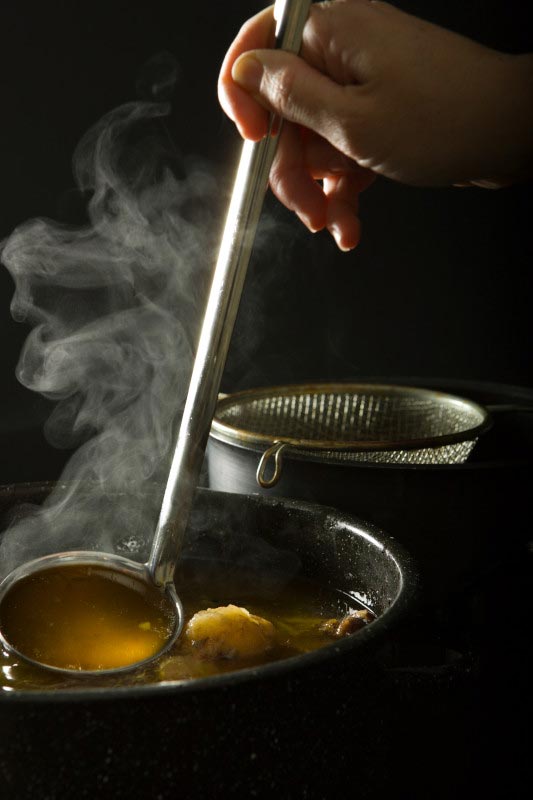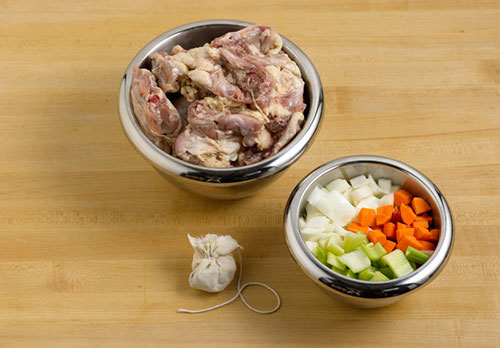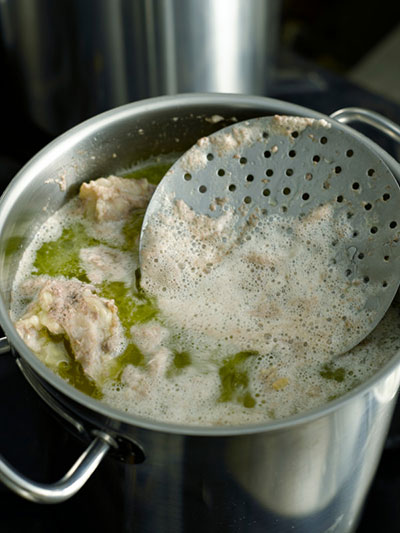Whether you're facing cold and flu season or are simply craving a rich and hearty soup, preparing a high-quality chicken stock (or, bone broth as it's sometimes called) is an essential kitchen tool. There are plenty of guidelines and ratios to help you make the perfect stock, and while these are helpful, this technique is hugely adaptable to your tastes, use, and pantry.
As a refresher: the difference between a broth and a stock is the primary ingredient. Broths use meaty cuts that flavor the broth, like whole chickens or leg quarters. Stocks use primarily bones, resulting in a stock that is rich with collagen. This is why stocks, when chilled, form a gelatinous texture. This is what makes a stock taste more flavorful and savory than a simple broth.
Because a stock uses primarily bones, it is an opportunity to utilize leftover trim and scraps from other recipes. The leftover carcass from a roasted chicken (or even store-bought rotisserie chicken) can be frozen and used in stock, as can bones from chicken wings, bone-in thighs, and virtually any other boney item you may have leftover. The bones don't need to be stripped of meat, and in fact, if you are purchasing chicken to use for the stock, you may even have trouble finding bones-only at your market. In this case, you're simply making a broth/stock hybrid with the added perk of shredded chicken to add to a soup or other recipe. Great cuts to purchase for this purpose are chicken legs, wings, and thighs, which have plenty of connective tissue. If available, chicken necks, backs, and feet are inexpensive and collagen-rich.
 Stocks typically include aromatic ingredients like onion, carrot, celery, garlic, and herbs to flavor the liquid. We're including the standard ratio below, but this is just a guideline. Just like when making vegetable stock, this is a great opportunity to use your saved veggie scraps, like carrot peels, spare garlic cloves, and onion ends. You can add a whole head of garlic, cut in half, if you like, and whatever herbs you like best. When making large batches, it is helpful to keep the flavor neutral, since you'll be using the stock in many different ways, but it's your stock, so you can add flavoring ingredients like ginger, turmeric, chiles, or cilantro stems, if you like.
Stocks typically include aromatic ingredients like onion, carrot, celery, garlic, and herbs to flavor the liquid. We're including the standard ratio below, but this is just a guideline. Just like when making vegetable stock, this is a great opportunity to use your saved veggie scraps, like carrot peels, spare garlic cloves, and onion ends. You can add a whole head of garlic, cut in half, if you like, and whatever herbs you like best. When making large batches, it is helpful to keep the flavor neutral, since you'll be using the stock in many different ways, but it's your stock, so you can add flavoring ingredients like ginger, turmeric, chiles, or cilantro stems, if you like.
In professional kitchens, stocks are typically left unseasoned, meaning no salt. This is so they can be used as a base for sauces and soups, without concern of over-salting. You can do this at home, if you like, but there is no harm in lightly salting the stock to build flavor if you prefer.
As for cooking times, we recommend 4 to 5 hours for your stock, but like all recipes, it's done when it's done. Taste your stock as it cooks. When it tastes flavorful, savory, and rich (versus watered-down and thin), it's done. If you're making the stock for sipping or for sick-days, you can simmer it longer to reduce the stock and make it extra strong. You may be inclined to cook the stock hotter, at a rolling boil instead of a simmer, to save time. While this is generally fine (again, it's your stock), it will create a cloudy stock with more particulates. It is generally preferred to cook the stock gently for a stock that appears clearer.
While the stock simmers, you may see bits of grey foam collecting at the surface. This is normal, and you can easily remove it using a ladle or slotted spoon.  You will also notice fat rising to the top of your stock, especially if you've used whole cuts that include skin, like thighs or wings. You can use a ladle to strain this from the soup as it cooks, or you can wait until the stock is cooled, when the fat will harden at the top. You can simply scrape it off. Save this fat, if you like, and use it as schmaltz.
You will also notice fat rising to the top of your stock, especially if you've used whole cuts that include skin, like thighs or wings. You can use a ladle to strain this from the soup as it cooks, or you can wait until the stock is cooled, when the fat will harden at the top. You can simply scrape it off. Save this fat, if you like, and use it as schmaltz.
Once your stock is finished, you'll need to strain it and then cool it as quickly as possible before storing. One of the quickest ways to cool your stock is to transfer it to shallow baking dishes or other bowls. The more surface area exposed to the air, the cooler it will cool. Once cooled, you can refrigerate or freeze your stock to use as needed.
Below is the CIA's standard chicken stock ratio and method. It cannot be overstated that this is a guideline, and you can adjust these quantities to your preferences. You can also replace the chicken bones with those of beef, pork, or lamb and follow all the same principles.
Chicken Stock
Makes 1 gallon
Ingredients
- 8 lb chicken bones
- 5 quarts water
- 8 oz yellow onion, roughly chopped
- 4 oz carrot, roughly chopped
- 4 oz celery, roughly chopped
- 2 sprigs thyme
- 1 bay leaf
- 1 teaspoon cracked black peppercorns
Directions
- Rinse the bones under cool running water and place them in an appropriate size stockpot.
- Add the cold water to cover the bones by about 2 inches. Slowly bring to a simmer. Skim the surface as necessary.
- Simmer for 3 to 4 hours at approximately 180°F.
- Add the mirepoix and sachet and continue to simmer the stock 1 hour more, skimming as necessary and tasting from time to time.
- Strain the stock. It may be used now (degrease by skimming, if necessary) or rapidly cooled and stored for later use.


